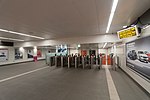St George's Tron Church
19th-century Church of Scotland church buildingsCategory A listed buildings in GlasgowChurch of Scotland churches in GlasgowChurches completed in 1808Listed churches in Glasgow ... and 2 more
Terminating vistas in the United KingdomUse British English from December 2017

The St George's Tron Church, in Glasgow, Scotland, is a Church of Scotland church in the city centre, located in Nelson Mandela Place, previously known as St George's Place, fronting Buchanan Street at West George Street, along from Queen Street Station. It should not be confused with the 17th-century Tron Church, which lies to the south-west on Trongate and was redeveloped in the 1980s as the Tron Theatre. Located right on the busiest shopping street in Scotland (Buchanan Street), the building is a significant presence, and the oldest in the area. It stands as a terminating vista for West George Street.
Excerpt from the Wikipedia article St George's Tron Church (License: CC BY-SA 3.0, Authors, Images).St George's Tron Church
Nelson Mandela Place, Glasgow Cowcaddens
Geographical coordinates (GPS) Address Nearby Places Show on map
Geographical coordinates (GPS)
| Latitude | Longitude |
|---|---|
| N 55.861832 ° | E -4.253941 ° |
Address
Nelson Mandela Place
Nelson Mandela Place
G2 1QY Glasgow, Cowcaddens
Scotland, United Kingdom
Open on Google Maps









